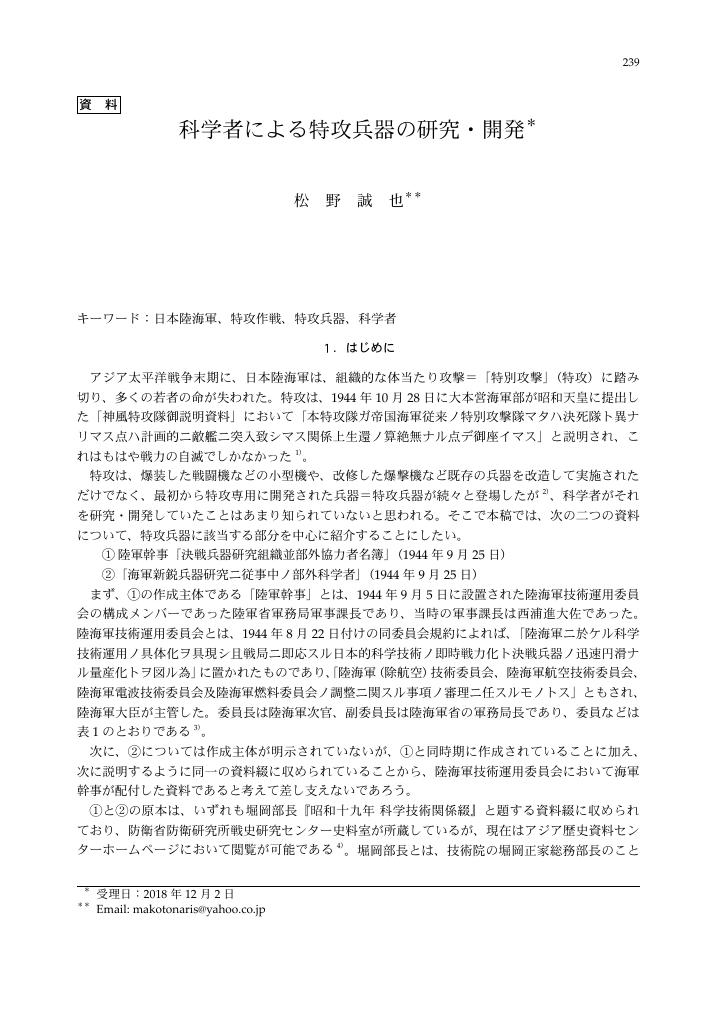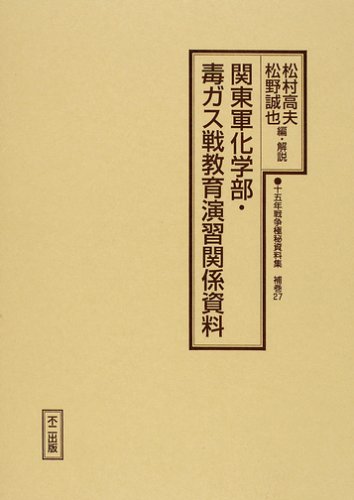48 0 0 0 OA 陸軍慰安所における軍紀・風紀についての一考察 ─慰安所で発生した事件やトラブルの実態─
- 著者
- 松野 誠也
- 出版者
- 中央大学商学研究会
- 雑誌
- 商学論纂 (ISSN:02867702)
- 巻号頁・発行日
- vol.58, no.5・6, pp.205-237, 2017-03-01
3 0 0 0 OA 科学者による特攻兵器の研究・開発
- 著者
- 松野 誠也
- 出版者
- 日本科学史学会
- 雑誌
- 科学史研究 (ISSN:21887535)
- 巻号頁・発行日
- vol.58, no.291, pp.239-248, 2019 (Released:2021-01-24)
3 0 0 0 関東軍と満洲国軍
- 著者
- 松野 誠也
- 出版者
- 青木書店
- 雑誌
- 歴史学研究 (ISSN:03869237)
- 巻号頁・発行日
- no.949, pp.34-48, 2016-10
2 0 0 0 OA 陸軍兵器行政本部「昭和二十年度 部外研究事項調」
- 著者
- 松野 誠也
- 出版者
- 日本科学史学会
- 雑誌
- 科学史研究 (ISSN:21887535)
- 巻号頁・発行日
- vol.56, no.282, pp.5, 2017 (Released:2021-01-10)
- 著者
- 松野 誠也
- 出版者
- 中央大学商学研究会
- 雑誌
- 商学論纂 = The journal of commerce (ISSN:02867702)
- 巻号頁・発行日
- vol.58, no.5, pp.205-237, 2017-03
- 著者
- 小熊 忠教 畑山 明広 松野 誠夫
- 雑誌
- 東日本臨床整形外科学会雑誌 = The East Japan journal of clinical orthopaedics (ISSN:09158855)
- 巻号頁・発行日
- vol.7, no.2, pp.169-174, 1995-06-20
- 参考文献数
- 18
- 被引用文献数
- 8
1 0 0 0 IR 日本陸軍の秘密戦器材 -防諜器材・諜報器材・謀略器材・宣伝器材の実態-
- 著者
- 松野 誠也
- 出版者
- 明治大学平和教育登戸研究所資料館
- 雑誌
- 明治大学平和教育登戸研究所資料館館報 (ISSN:24239151)
- 巻号頁・発行日
- no.6, pp.1-36, 2020-09-30
1 0 0 0 OA 日本陸軍による液体塩素工業の育成 : 化学兵器を事例とした軍産関係とデュアルユースの考察
- 著者
- 松野 誠也
- 出版者
- 日本科学史学会
- 雑誌
- 科学史研究 (ISSN:21887535)
- 巻号頁・発行日
- vol.58, no.290, pp.144-161, 2019 (Released:2021-01-24)
The Japanese Imperial Army worked on the production of liquid chlorine when it began research and development of chemical weapons that appeared in the WWI. The objective was to have liquid chlorine produced by commercial companies and delivered to the army. However, this project failed because of the high costs and lack of demand for the product in the civilian sector. Subsequently, the Japanese Imperial Army took up the challenge to procure the regular supply of liquid chlorine through dual use. This was made possible because disarmament allowed for increases in the research budget. It was also based on the initiative of Colonel Taneki Hisamura, who investigated in detail the chemical combat capabilities of European countries and the United States. Japan deemed it essential to realize the production of liquid chlorine in order to secure the raw material of the chemical agent. Having a total war in mind, Hisamura hoped that the liquid chlorine industry would cooperate with the military in times of war. His plan was to develop bleach that used liquid chlorine as the raw material. He believed that, if such a product spread, the civilian demand for liquid chlorine would soon expand. In the case of Japan, the dual use promoted by the army succeeded in the development of the liquid chlorine industry. In this way, the Japanese Imperial Army built a system that enabled mass production of liquid chlorine in peacetime.
1 0 0 0 関東軍化学部・毒ガス戦教育演習関係資料
- 著者
- 松村高夫 松野誠也編・解説
- 出版者
- 不二出版
- 巻号頁・発行日
- 2006
- 著者
- 松野 誠也
- 出版者
- 日本の戦争責任資料センター
- 雑誌
- 戦争責任研究 = The report on Japan's war responsibility (ISSN:13437348)
- 巻号頁・発行日
- no.87, pp.80-85, 2016
1 0 0 0 OA 森山威男のフリースタイル奏法のデジタルアーカイブ作成および対話を通じた分析と考察
フリー・スタイルであるのにスイングするという独特の演奏法を編み出し、1974年のヨーロッパ公演では爆発的な反響と評価を勝ち取った「初期山下洋輔トリオ」の技術構成について、ドラマーである森山威男氏のドラミングを撮影することを通じて解明した。フリー・スタイルであるのにスイングする秘訣は、固定したメンバーと演奏を繰り返し、ビートや楽譜ではなく「間」を共有することにある。それを実証するために、森山・山下、森山・坂田のデュオを収録した。本研究の成果は追加画像も含めてヤマハ・ミュージック・エンターテインメント・ホールディングスから今年中に出版される予定で、鋭意編集中である。


